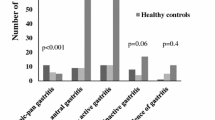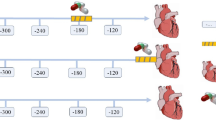Abstract
The use of NSAIDs is strongly associated withpeptic ulceration. The inhibition of prostaglandinsynthesis with the consequent increase of gastricacidity is considered a possible mechanism. Therefore we decided to assess the effect of one-monthtreatment with NSAIDs on the circadian gastric pH ofrheumatoid arthritis (RA) patients. We studied 11consecutive patients (one man and 10 women, median age55, range 26-72 years) with confirmed RA. None wasH. pylori positive. A 24-hr gastric pH recording wasperformed both in basal conditions and after one-monthtreatment with either indomethacin 150 mg/day (eight cases) or ketoprofen 300 mg/day (three cases).Only the 10 female patients were eligible for finalanalysis, and six matched healthy subjects not takingNSAIDs were used as control group. The number of 24-hr pH readings for various pH thresholds wascalculated for both populations. The highest acid levels(pH < 3.0) did not differ between the two pH profilesof the control group (7440 vs 7391, P = NS), while they predominated after the one-month NSAIDtreatment (10,339 vs 11,440, P < 0.001) in RApatients. These findings show that there is an increasedgastric acidity after one-month of treatment with NSAIDs in female patients with RA of recent onset.This may sustain the rationale of using antisecretoryagents to prevent gastroduodenal ulcerations in thesepatients.
Similar content being viewed by others
REFERENCES
Mahmud T, Scott DL, Bjarnason I: A unifying hypothesis for the mechanism of NSAID related gastrointestinal toxicity. Ann Rheum Dis 55:211- 213, 1996
Morini G, Grandi D, Arcari ML, Bertaccini G: Indomethacin-induced morphological changes in the rat gastric mucosa, with or without prior treatment with two proton pump inhibitors. Aliment Pharmacol Ther 9:615- 623, 1995
Lichtenstein DR, Syngal S, Wolfe MM: Nonsteroidal anti-inflammatory drugs and the gastrointestinal tract. Arthritis Rheum 38:5- 18, 1995
Scheiman JM: Pathogene sis of gastroduodenal injury due to nonsteroidal antiinflammatory drugs: Implications for prevention and therapy. Semin Arthritis Rheum 21:201- 210, 1992
Winship DH, Bernhard GC: Basal and histamine stimulated human gastric secretion: Lack of effect of indomethacin in therapeutic doses. Gastroenterology 58:762- 765, 1970
Bennett A, Stanford IF, Unger WG: Prostaglandin E2 and gastric acid secretion in man. J Physiol 229:349 - 360, 1973
Feldman M, Coltui TJ: Effect of indomethacin on gastric acid and bicarbonate secretion in humans. Gastroenterology 87:1339 - 1343, 1984
Rademaker JW, Rainsford KD, Stetsko PI, Johnson DM, Chiba N, Mcdonald TM, Hunt RH: The effect of indomethacin induced gastric mucosal injury on 24-h intragastric acidity and plasma gastrin concentration in healthy volunteers. Aliment Pharmacol Ther 9:625- 631, 1995
Janssen M, Baak LC, Jansen JBMJ, Dijkmans BAC, Vandenbrouke JP, Lamers CBHW: Effects of indomethacin on intragastric pH and meal-stimulated serum gastrin secretion in rheumatoid arthritis patients. Aliment Pharmacol The r 7:393- 400, 1993
Moss SF, Calam J: Acid secretion and sensitivity to gastrin in patients with duodenal ulcer: The effect of eradication of Helicobacter pylori. Gut 34:888 - 898, 1993
Arnett FC, Edworthy SM, Block DA: The American Rheumatism Association 1987 revised criteria for the classification of rheumatoid arthritis. Arthritis Rheum 31:315- 324, 1988
El Omar EM, Penman ID, Ardill JE, Chittajallu RS, Howie C, McColl KE: Helicobacter pyloriinfection and abnormalities of acid secretion in patients with duodenal ulcer disease. Gastroente rology 109:681- 691, 1995
Patrono C, Patrignani P, Panara MR, Cipollone F, Santini G, Sciulli MG: COX-2 expression and inhibition in human monocytes. InImproved Non-Steroid Anti-Inflammatory Drugs. COX-2 Enzyme Inhibitors. J Vane, J Botting, R Botting (eds). Dordrecht, Kluwer Academic, 1996, pp 121- 131
Lind T, Cederberg C, Ekenved G, Haglund U, Olbe L: Effect of omeprazole—a gastric proton pump inhibitor on pentagastrin stimulated acid secretion in man. Gut 24:270 - 276, 1983
Mela GS, Savarino V, Malesci A, Di Mario F, Sossai P, Vigneri S, Zambotti A: New method for improving accuracy of 24-hour continuous intragastric pH-metry. Reflections on physiological and pharmacological studies. Dig Dis Sci 39:1416 - 1424, 1994
Mela GS, Savarino V, Moretti M, Bonifacino G, Sumberaz A, Zentilin P: Clinical relevance of sampling rate in the characterization and analysis of 24-hour gastric acidity. A report on 413 cases. Scand J Gastroenterol 24:683- 687, 1989
Mela GS, Savarino V, Vigneri S: Optimizing the information obtained from continuous 24-hour pH monitoring. Am J Gastroenterol 87:961- 966, 1992
Harris ED Jr: Etiology and pathogenesis of rheumatoid arthritis. InTextbook of Rheumatology. VN Kelley, Ed Harris Jr, S Ruddy, H Sledge (eds). Philadelphia, WB Saunders, 1993, pp 833- 873
De Witte TJ, Geerdink PJ, Lamers CB, Boerbooms AM, Van der Korst JK: Hypochlorhydria and hypergastrinemia in rheumatoid arthritis. Ann Rheum Dis 38:14 - 17, 1979
Baron JH: Lean body mass, gastric acid and peptic ulcer. Gut 10:637- 642, 1963
Griffin MR, Piper JM, Daugherty JR, Snowden M, Ray WA: Nonsteroidal anti-inflammatory drug use and increased risk for peptic ulcer disease in elderly persons. Ann Intern Med 114:257- 263, 1991
French PC, Darekar BS, Mills JG, Wood JR: Ranitidine in the prevention of non-steroidal anti-inflammatory drug-associated gastric and duodenal ulceration in arthritic patients. Eur J Gastroenterol Hepatol 6:1141- 1147, 1994
Taha AS, Hudson N, Hawkey CJ, Swannel AJ, Trye PN, Cottrel J, Mann SG, Simon TJ, Sturrock RD, Russell RI: Famotidine for the prevention of gastric and duodenal ulcers caused by nonsteroidal antiinflammatory drugs. N Engl J Med 334:1435- 1439, 1996
Daneshmend TK, Stein AG, Bhaskar NK, Hawkey CJ: Abolition by omeprazole of aspirin-induced gastric mucosal injury in man. Gut 31:514 - 517, 1990
Ekström P, Carling L, Wetterhus S, Wingren PE, Anker-Hansen O, Lundegärdh G, Thorhallsson E, Unge P: Prevention of peptic ulcer and dyspeptic symptoms with omeprazole in patients receiving continuous non-steroidal anti-inflammatory drug therapy. A Nordic multicentre study. Scand J Gastroenterol 31:753- 758, 1996
Cullen D, Bardhan KD, Eisner M, Kogut DG, Peacock RA, Thomson JM, Hawkey CJ: Primary gastroduodenal prophylaxis with omeprazole for NSAID users. Gastroenterology 110:A86, 1996
Rights and permissions
About this article
Cite this article
Savarino, V., Sandro, G., Zentilin, M.P. et al. Effect of One-Month Treatment with Nonsteroidal Antiinflammatory Drugs (NSAIDs) on Gastric pH of Rheumatoid Arthritis Patients. Dig Dis Sci 43, 459–463 (1998). https://doi.org/10.1023/A:1018834301901
Issue Date:
DOI: https://doi.org/10.1023/A:1018834301901




